Archive for Places to go
May 22, 2008 at 7:06 pm · Filed under Places to go, Roadtrips
I like driving Route 13 up the eastern seashore. The road is smooth, level, and lightly trafficked. All through the tow the Nissan hummed steadily as it tugged the Airstream through quiet green countryside up into Maryland.
We made one important stop, at The Great Machipongo Clam Shack, to stock the freezer and buy seafood sandwiches for lunch. I say “important” because we know the place and love the food, but also because it has fast wi-fi which reaches across their roomy parking lot. Twenty-seven huge emails had piled up over the last few weeks which I have been unable to download efficiently over my cellular Internet connection. All of them downloaded quickly while Eleanor was inside ordering lunch.
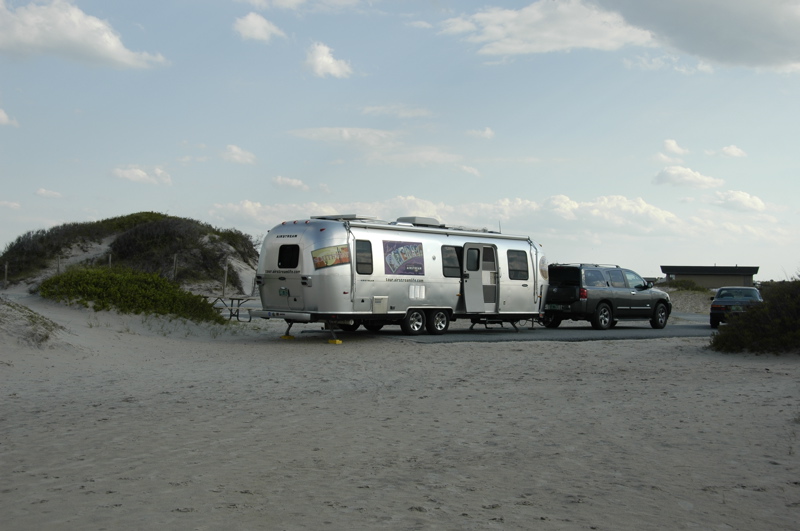
Assateague National Seashore looks at first a lot like the Outer Banks: a barrier island, lots of sand, sea oats, and other salt-adapted plants. But it has one significant element that other barrier islands don’t have, namely wild ponies. They have been living here for centuries, perhaps survivors of a Spanish ship that sank off shore, and they are a major tourist attraction.
 We have yet seen them, but their signs are everywhere. Hoof prints are in the sand by our campsite, and horse manure is scattered along the narrow campground roads. In backing up the Airstream I was forced to drive right through a nice heap of manure, which is the first time that’s happened in our travels.
We have yet seen them, but their signs are everywhere. Hoof prints are in the sand by our campsite, and horse manure is scattered along the narrow campground roads. In backing up the Airstream I was forced to drive right through a nice heap of manure, which is the first time that’s happened in our travels.
If you come here, note that there are two campgrounds adjacent to each other on the barrier island. One is state park, and the other is national park. The national park sites are $20 per night (versus $30 for the state park) and have the same services: nothing. But the national park requires a $15 per vehicle entrance fee, so for a single night it’s cheaper to take the state park unless you have a national parks pass.
We ended up in the state park because of site availability. There, you’ll find a huge variation in the length of campsites. It’s impossible for longer trailers like ours to back into a site without the tow vehicle driving on the sand (and maybe manure) at least a little. The registration desk has a book listing all the site lengths and it’s a good idea to check it before you pick one. We needed a huge site to fit all three vehicles (remember the Honda?).
It’s beautiful on the island, but I can’t help the sense of “We just did this.” One barrier island is much like another. The wind this afternoon was like the Outer Banks at their worst, whistling and howling and throwing sand in our faces. We tried to walk to the beach but the tiny particles stung our legs and wriggled into our eyes. I’m afraid that means we won’t be able to properly investigate the place with the time we have.
We would stay several nights, but Memorial Day weekend begins tomorrow, and both the state and national park sites on the island are completely booked. We anticipated this. We could have allowed more nights here if we had left the Outer Banks a day or two earlier, or driven right through instead of stopping at Koptopeke last night. There’s always a compromise somewhere, and in this case Assateague got the short end of the stick. We will have to leave in the morning.
We could have made reservations for this weekend, but that would have required us to nail down our exact trip plan weeks ago. Instead, we left it open, trusting that some sort of plan would emerge, and one did: we are going to spend the weekend courtesy parking at the home of fellow Washington DC Unit (WBCCI) members Star & Peter, up in New Hope PA.
That’s ideal, since they have hookups on their property, don’t mind us coming or going whenever we want, and by courtesy parking we are saving money too. Their house is near Philadelphia so I expect at some point we’ll make a day trip in to the city.
Assateague will be on our “return” list to visit again someday when we have time to explore it. I’d like to be able to photograph the wild ponies, ride the bike trails, and drive down the 4WD section of beach. See, even full-timers don’t always have time to do everything they want. It’s a big country and a lifetime is barely enough time to explore it.
Our coordinates tonight: 38 °13’58.15″N 75 ° 8’28.59″W
May 19, 2008 at 7:35 pm · Filed under Places to go
For me, it wouldn’t be a visit to the Outer Banks if we didn’t go to the Wright Brothers Memorial, so last week I had my mail forwarded to the Kill Devil Hills post office about two blocks away. That made picking up the mail much less of an errand, and more of an exciting prelude.
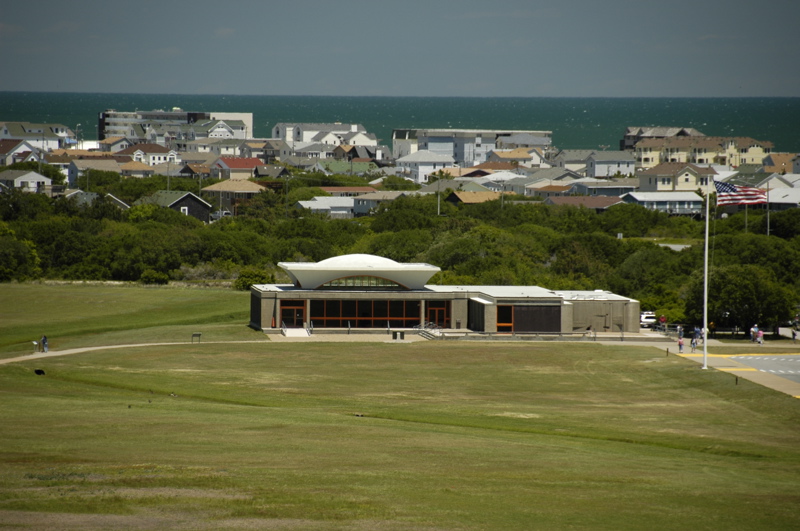
It is a national park site, so our “America the Beautiful” inter-agency pass got us in without paying the $4 per person fee. Regardless of whether you pay, I think the site is well worth a visit. The talk in the Visitor Center we attended was superb, and the whole area is beautiful, especially the view from the top of the hill where the monument sits.
I took many more pictures of the place than I can fit in the blog, so I’ve added 16 images to Flickr in a new photoset. You can check them out here.
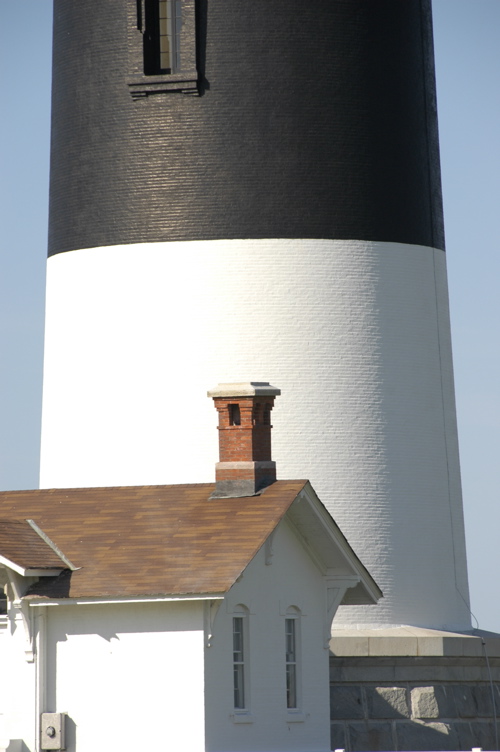 We also dropped in on the Fort Raleigh National Historic Site in Manteo. This is an almost spooky place because of the strange history of the British colony which disappeared without a trace while their governor John White was back in England trying to get supplies. We started the Junior Ranger program there, but it was a tough one and so Emma took it home for completion later. There’s not a lot to see outside the Visitor Center since nothing remains of the original colony (unless you are an archaeologist), but I recommend it to history buffs.
We also dropped in on the Fort Raleigh National Historic Site in Manteo. This is an almost spooky place because of the strange history of the British colony which disappeared without a trace while their governor John White was back in England trying to get supplies. We started the Junior Ranger program there, but it was a tough one and so Emma took it home for completion later. There’s not a lot to see outside the Visitor Center since nothing remains of the original colony (unless you are an archaeologist), but I recommend it to history buffs.
Our third stop of the day was to yet another lighthouse. Care to guess which one? It’s pretty easy, since we’ve been to the other two major lighthouses of the Outer Banks already. Actually, you can tell by the stripes if you have a guidebook to North Carolina lighthouses.
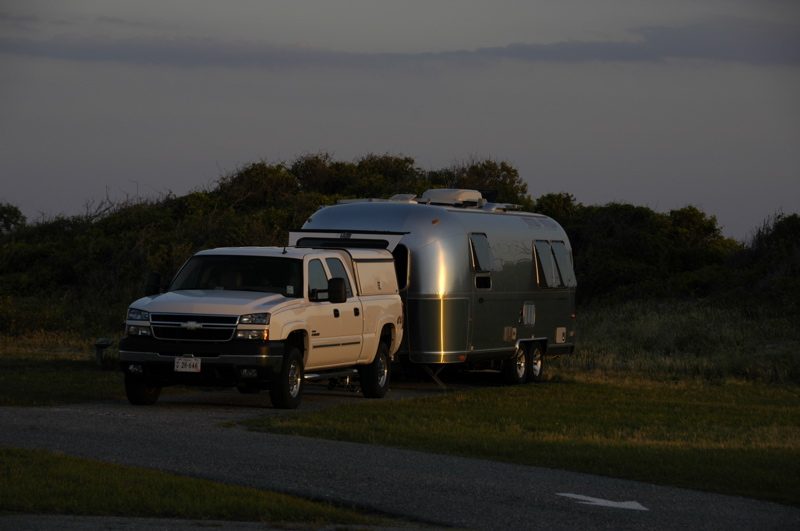 Zach, Deb, and Zane have moved on, pressed by their schedule to return to home base in Massachusetts this week. But we were delighted to find our new friends the Hallingers waiting for us back at the campground when we returned. They moved up from Frisco to Oregon Inlet in part to hang out with us (I think, since they parked nearby us). That’s a huge bonus for us since Emma is compatible with their 5 and 7-year old girls.
Zach, Deb, and Zane have moved on, pressed by their schedule to return to home base in Massachusetts this week. But we were delighted to find our new friends the Hallingers waiting for us back at the campground when we returned. They moved up from Frisco to Oregon Inlet in part to hang out with us (I think, since they parked nearby us). That’s a huge bonus for us since Emma is compatible with their 5 and 7-year old girls.
Our plan was to leave tomorrow, but I am rethinking it now. I could use a pure work day, and Emma has friends nearby, so we may stay just one more night. Of course, that’s what we kept saying back at Frisco and we ended up staying five nights … but now we have a plan for the next fourteen days and we have less flexibility. I think we’ll have to get going soon.
May 18, 2008 at 8:09 pm · Filed under Places to go
We’ve finally moved on from Frisco campground, to a site about 50 miles north called Oregon Inlet. The Outer Banks are really too big to explore from a single base, unless you are willing to spend a lot of time in the car. We got a good look at the southern end, and now we are going to take a couple of days to check out things at the northern end. Zach, Deb, and Zane moved along with us, so we are parked directly across from each other in the campground.
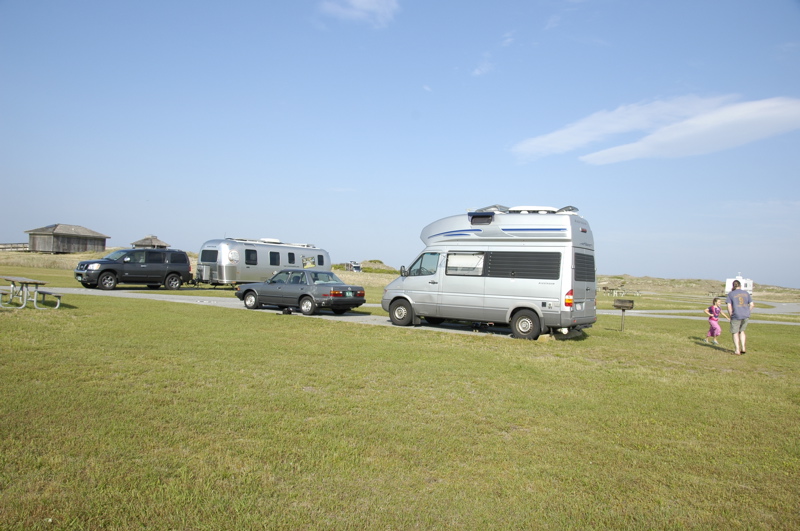
As with Frisco, Oregon Inlet is a no-reservations “first come first served” campground. This time of year strikes me as ideal to come here, because the campgrounds are virtually empty (well, those campgrounds in the National Seashore, because they have no hookups), the mosquitoes are hardly noticeable, and the weather is fine. I’m told that in the summer the mosquito situation is quite different, and I’m sure even the primitive campgrounds get busy. Right now we are two of about 15 rigs camped here, so we had our pick of sites.
We chose a site far from the beach. The wind is back to the gale-force level, which it seems to be a lot here. It is a palpable and constant presence, thundering in the ears, rocking the trailer, and causing the little Honda to wander on the roads. It blows salt water from the Sound over the roads, leaving corrosive floods by the roadsides. Conversation outside is difficult at times, and fine sand blows across the roads and beaches with stinging force. I can’t remember being in a place where sand was constantly airborne in tan waves, other than here.
It is finally starting to affect me. This morning, practicing on the ukulele, I found I could no longer sing the high notes in most of the songs. I’ve begun to cough. The airborne salt and sand is aggravating my throat, I think. We’ll be leaving Tuesday, and I hope that by then I haven’t lost my voice entirely.
Since we were towing the trailer north this morning, we took the opportunity to take care of a few things it needed. We emptied the holding tanks and filled the fresh water tank at the unmarked (and unmentioned on the national parks website) dump station near the Hatteras Lighthouse. Go past the lighthouse about 1 mile and it is on the left side of the road. I don’t know why the location of this dump station is treated as such a secret since it is clearly there for the benefit of people staying at the Frisco or Cape Point national seashore campgrounds. Maybe signs go up when Cape Point campground opens later this month.
Another well-kept secret: in the town of Salvo is a BP gas station with an outdoor car wash large enough for easy entry and exit of a truck with 30-foot trailer. We found this and took the opportunity to rinse off the outside and underbelly of the Airstream, which had gradually become coated with a thin film of dried salt.
Also, on the way in through Ocracoke, we had splashed through a few of those roadside puddles. You can imagine the grimace on my face when that happened. The Airstream is in no way rustproofed, so I was eager to get it rinsed. We stuffed $2.50 worth of quarters in the machine and managed to get the job mostly done. A small amount of salt seems to have stuck despite the rinse, so we’ll have to stop for a better wash later.


Just south of Oregon Inlet is the Pea Island National Wildlife Refuge, a huge area maintained specifically to create an ideal environment for migratory birds. There’s a visitor’s center and a “boardwalk” trail 3/4 miles long, plus another 3 miles or so of good trail in a loop.
 I had visions of hiding in one of the bird blinds and getting some amazing photos, but my 200mm lens is not really up to the task. The serious bird photographers were toting 300 lenses at a bare minimum. The wind was also a detriment, so strong at times that it was hard to hold the camera steady.
I had visions of hiding in one of the bird blinds and getting some amazing photos, but my 200mm lens is not really up to the task. The serious bird photographers were toting 300 lenses at a bare minimum. The wind was also a detriment, so strong at times that it was hard to hold the camera steady.
Although the wind has been a nuisance at times, in another way it is comforting. We expected constant rain and we got it when we went to the Hoh rain forest of Olympic National Park. We expected scorching heat when we camped in Death Valley two Junes ago, and we got it. The wind and blowing sand here is exactly what I expected, along with a parade of dramatic clouds and salty air. It will be the signature memory of the Outer Banks when we think of it later, the ever-present warm breeze that rocked our trailer and kept us comfortable despite humidity all night long.
May 15, 2008 at 9:33 pm · Filed under Places to go
Ocracoke is the southernmost of the inhabited Outer Bank islands, and was the subject of much of Bert Gildart’s article on the Outer Banks that appeared in the Spring 2008 issue of Airstream Life magazine. Bert’s article was a key inspiration for us to come here, so we wanted to explore it before we migrated north.
To get to Ocracoke from Hatteras, you take a free ferry. The ferry is 40 minutes long and runs every half-hour. We had worked that into our schedule, but we hadn’t foreseen massive congestion at the ferry dock. So many people were waiting in line that although we arrived at 11 a.m., we had to wait until 12:30 to get on a ferry. Fortunately, we’d brought lunch …
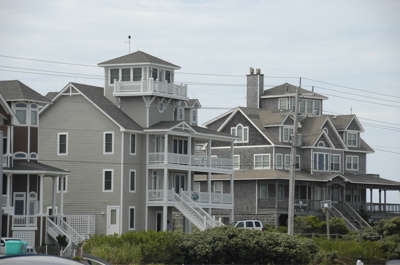 Near the ferry dock are many examples of overly massive houses that appear to be relatively new. The size of these McMansions is astonishing, especially on an island with limited natural resources (fresh water, sewage disposal, fuel, space). Most of them seem to be four stories tall, and we are talking about single-family homes. Presumably some are rentals. If the Park Service didn’t own most of the land, these islands would be absolutely overrun with hideous development and the local character of the islands would disappear.
Near the ferry dock are many examples of overly massive houses that appear to be relatively new. The size of these McMansions is astonishing, especially on an island with limited natural resources (fresh water, sewage disposal, fuel, space). Most of them seem to be four stories tall, and we are talking about single-family homes. Presumably some are rentals. If the Park Service didn’t own most of the land, these islands would be absolutely overrun with hideous development and the local character of the islands would disappear.
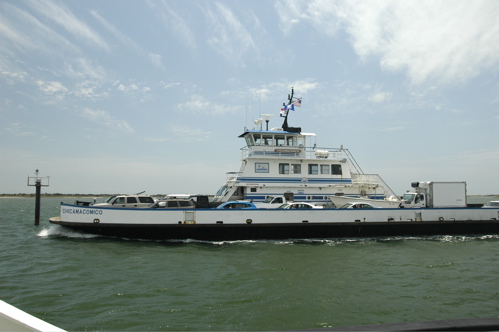 I’d recommend the ferry as a fun & free tour, if it weren’t for the wait we encountered. Getting a few miles from Hatteras to Ocracoke took us over two hours, but once the boat starts moving it’s a nice trip.
I’d recommend the ferry as a fun & free tour, if it weren’t for the wait we encountered. Getting a few miles from Hatteras to Ocracoke took us over two hours, but once the boat starts moving it’s a nice trip.
On a calm day the water is clear green and the shifting sand below is clearly visible. The channel that the ferry runs in is very shallow. A crewmember on the ferry told us that if the ferry sank, the people standing on deck wouldn’t even get their feet wet.
Emma was a bit concerned that in heavy seas the boat might tip over. In fact, it would strike the bottom before it could tip that far. Even if you fell off you could swim a hundred feet and then walk the rest of the way to shore. But if you don’t know this, it does seem like you are out in the vast ocean at times, especially when large swells come in from the Atlantic through the inlet between islands.
 Ocracoke is basically a lot of National Seashore with a small town at the southern end. The town is a cross between a charming historical village and a modern tourist trap. You can see the ongoing struggle between the two. It seems like the factions have each established their own strongholds: modern tourism along the harbor, and historical treats hidden on interior streets paved with oyster shells.
Ocracoke is basically a lot of National Seashore with a small town at the southern end. The town is a cross between a charming historical village and a modern tourist trap. You can see the ongoing struggle between the two. It seems like the factions have each established their own strongholds: modern tourism along the harbor, and historical treats hidden on interior streets paved with oyster shells.

There are a few interesting things to see in town: a couple of historical cemeteries, the lighthouse, the harborfront. (You’ll see that despite my earlier complaints about photographing lighthouses, I couldn’t resist trying again today.) To really get involved you will want to talk to people and hear the stories. It’s all about the little things here. There’s no “high concept” entertainment. I would have liked an interpreted walking tour of town, but we got here so late because of the ferry delay that we didn’t have time. We settled for walking the town on our own, and three ice cream treats afterward.
If you care to keep your RV in the center of Ocracoke, within a short walk or bike ride of everything, you can stay where Bert & Janie stayed. There’s a small RV park called Teeter’s just off the main street, next to a historical cemetery and across the street from a candy stand. The park is just a grassy area crowded with RVs, but you’d go there to have the convenience of being right in town.
We have extended our stay in Frisco for another two nights. The cold showers are actually pretty refreshing after a day of sticky hiking, and I can’t think of any place to go to which would have a nicer view than this campground. Our water is holding out fine and our batteries are 98% full every afternoon. Friday we expect rain but that’s OK. I’m planning a work day and we’ll still get out for a little while anyway.
May 14, 2008 at 9:38 pm · Filed under Places to go
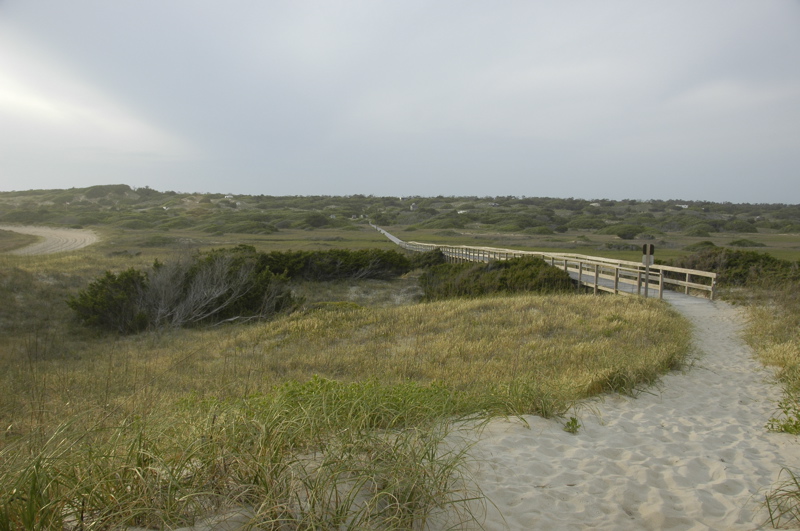
We made the right choice in coming to one of the National Seashore campgrounds. We are at Frisco, one of four campgrounds maintained by the National Park Service. The sites are well spaced and separated by dunes and natural vegetation. The views from the upper sites are magnificent, and the lower sites are just a short boardwalk from the beach. There is endless open beach to walk on, collect shells, surf, and even drive if you have 4WD.
Of course, this all comes at a price, and I don’t mean dollars. The “price” is some slight inconvenience. There are no hookups, and no dump station. This means we have to be very careful with our water usage if we want to stay a while. We have not had access to a dump station or electricity since we left Santee State Park three nights ago.
So we are using the campground showers, which feature only cold water. I tried them today and found that pulling the shower rope over my head resulted in a powerful inundation. It’s refreshing to say the least. Looking on the bright side, it gets the job done, and the cold water motivates you not to waste any.
The key to survival is to time the shower for the hottest part of the day. Since it’s currently not exceeding mid-70s here at any time of day, that means a limited window of cleansing opportunity. But this sort of inconvenience has kept the crowds away from our campground. They are at the many RV resorts in the area, where they can get full hookups, a game room, mini golf, a pool, laundry, etc. While those things are useful when you need them, we came here prepared to go without, specifically so we can stay here.
Electricity is no problem this time of year. The sites at Frisco have no overhanging shade trees, the days are long, and we don’t need the power-hungry furnace at night. Our two solar panels are producing much more power than we need. This morning we were fully re-charged before noon. Of course, if some weather moves in we would have much lower power generation, but we have enough battery capacity to ride out a couple of cloudy days.
Anyone who wanted to stay here in an RV could do as well as us even without a gray water holding tank or solar panels. A simple “blue boy” external wastewater holding tank, and a quiet Yamaha generator would do the trick.
 The first stop of our travels today was the iconic Hatteras Lighthouse. Everyone takes the same picture of the thing, and most of them are awful. It’s hard to photograph a really tall object (lighthouse, redwood tree, skyscraper) and end up with a photo that makes visual sense and looks interesting. I played around with it a little, but there wasn’t much satisfaction in it. I’d rather shoot photos that are more evocative, and a big stack of painted bricks just doesn’t do it for me.
The first stop of our travels today was the iconic Hatteras Lighthouse. Everyone takes the same picture of the thing, and most of them are awful. It’s hard to photograph a really tall object (lighthouse, redwood tree, skyscraper) and end up with a photo that makes visual sense and looks interesting. I played around with it a little, but there wasn’t much satisfaction in it. I’d rather shoot photos that are more evocative, and a big stack of painted bricks just doesn’t do it for me.

We were surprised to find that the National Seashore has a Junior Ranger program, which of course Emma had to do. It’s a pretty easy one, so she snagged her badge before lunchtime.
Everything is expensive on the islands, especially fuel. Now I regret passing up those gas stations in mainland North Carolina selling unleaded at $3.69. Here it is running as high as $4.07. But I was particularly offended by the local campground that refilled my 30# propane tank last night and presented me with a bill for a whopping $43.20! That’s six bucks a gallon, plus tax. When I commented on the outrageous price, I was told, “Gas is expensive. Everything costs.” For comparison, the current price in Richmond VA is $4.50 per gallon.
One of the activities on the island is to go to Hatteras Harbor when the fishing charters come back, around 4:00-5:00 pm, and see the catch. It’s a small show, watching the proud fishermen posing with their yellow fin tuna, king mackeral, wahoo and dolphin (not the porpoise type, but a fish). The fish sometimes cleaned right on the boat, and others are cleaned & frozen at a nearby hut.
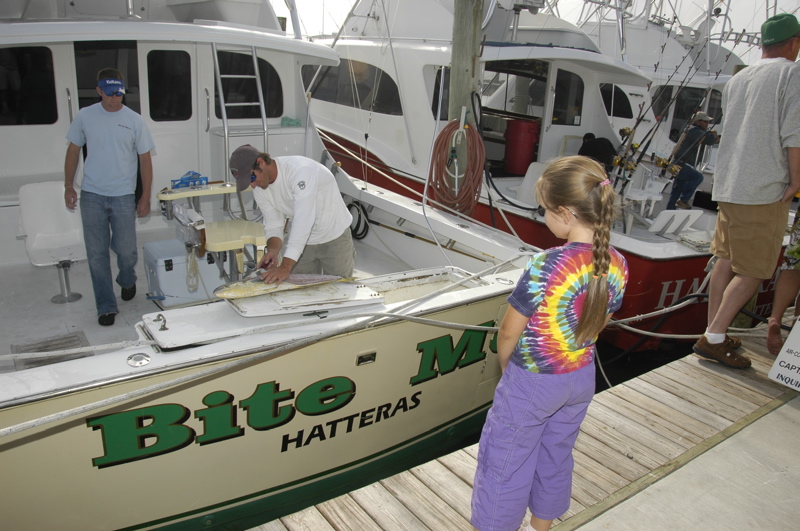
I took a lot of photos today from all over Cape Hatteras, more than I can fit into the blog, so there’s a new Flickr photoset online if you want to peruse that.
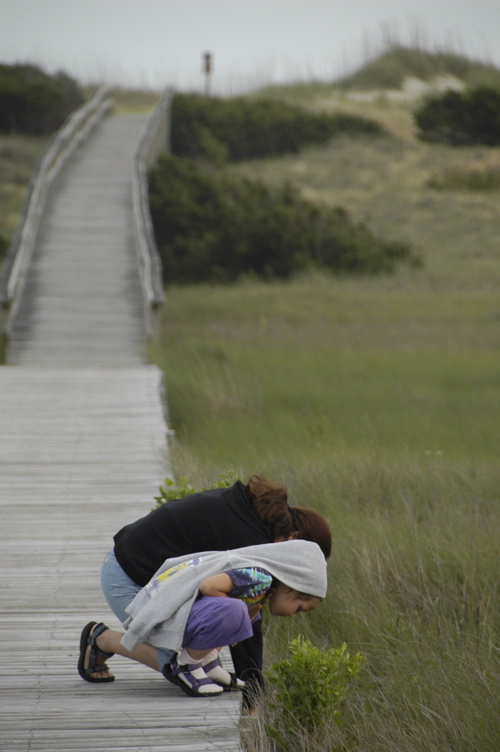 Our final activity of the day was to hit the beach. Yesterday it was too windy, but today things are much calmer. Two boardwalks stretch from campground to beach, so access is easy. The surf is still much too high for swimming, but there’s some shelling, some birding, and lots of space to just walk and breathe in the salty air. If you look closely, there are a lot of little things to occupy one’s attention.
Our final activity of the day was to hit the beach. Yesterday it was too windy, but today things are much calmer. Two boardwalks stretch from campground to beach, so access is easy. The surf is still much too high for swimming, but there’s some shelling, some birding, and lots of space to just walk and breathe in the salty air. If you look closely, there are a lot of little things to occupy one’s attention.
We bought two nights at Frisco when we arrived, but clearly we are going to need more time to explore the area. Other than the water limitations, we have no reason to leave. There aren’t any mosquitoes at all, I’m able to work conveniently from the Airstream, and we are in a nice spot at a cheap price. Tomorrow morning I’ll pay for a couple of more nights, and then we may move up the coast.
May 11, 2008 at 12:33 pm · Filed under Places to go
I’m finally getting to post at a grocery stop near Lumberton NC … there was no cell service in the state park campground. They did have wifi at the Visitor’s Center but I was too wiped out yesterday to make use of it.
Is it the humidity? I’m not sure, but after our day at Congaree National Park (about 35 miles north), we were all collapsing. We only hiked 2.4 miles on the boardwalks, so I can’t claim it was the exercise.
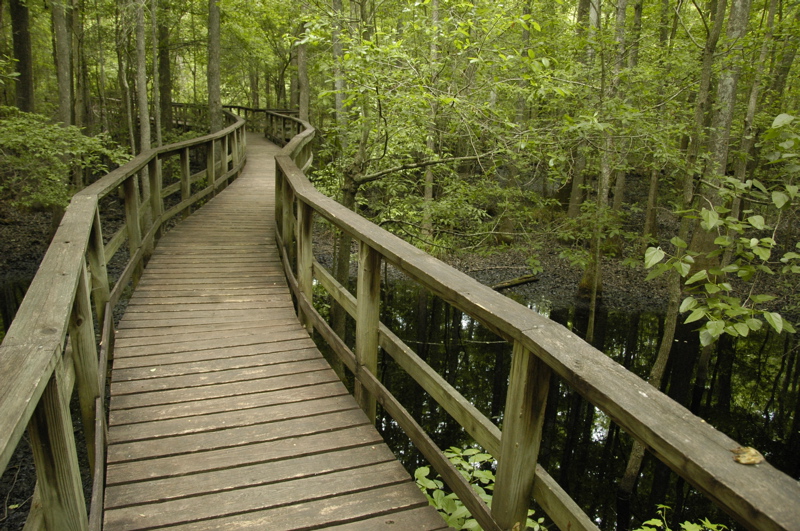
Congaree is a really “different” type of national park. At first glance, it’s a swamp. But there’s a lot more to it than that. It’s really a forest that floods about 10 times a year, and that regular flooding inspires an amazing diversity of creatures and plants. The trees are very tall — a fact of which the Visitor Center displays, brochures, and movie all tout extensively — and it has a canopy like a rain forest, so it’s dim and humid down below.
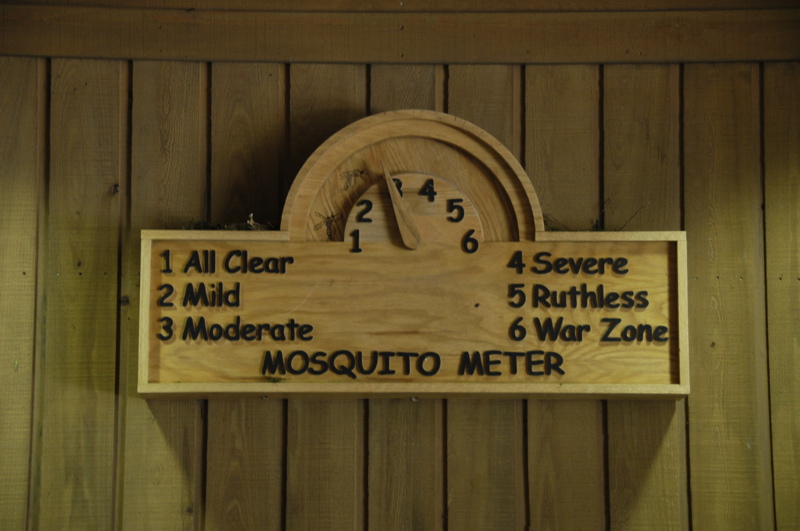 In our little 2.4 mile walk we managed to spot three different types of skink, some very pretty damsel flies, a barred owl (photo below), a snake we haven’t yet identified, and lots of other insects. Especially mosquitoes. This is the only national park we’ve ever seen with an official “mosquito meter.” Fortunately, the buggers were only “mild” by my estimation, and we brought deet along. I wouldn’t want to be here when the meter reads 5 or 6.
In our little 2.4 mile walk we managed to spot three different types of skink, some very pretty damsel flies, a barred owl (photo below), a snake we haven’t yet identified, and lots of other insects. Especially mosquitoes. This is the only national park we’ve ever seen with an official “mosquito meter.” Fortunately, the buggers were only “mild” by my estimation, and we brought deet along. I wouldn’t want to be here when the meter reads 5 or 6.
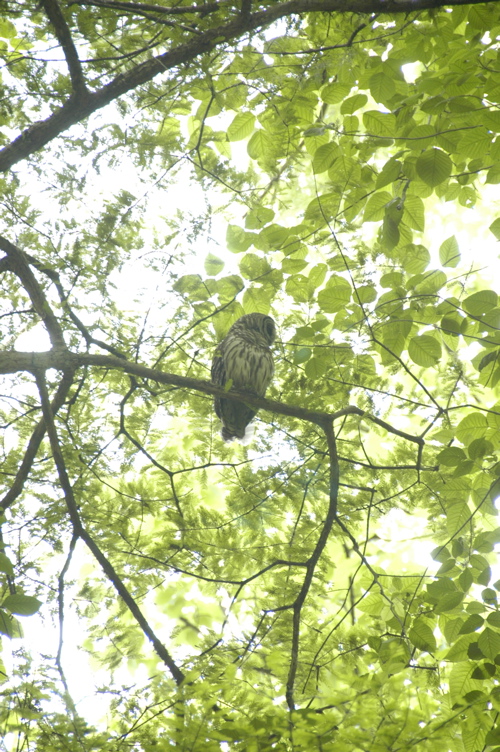
There are a lot of other trails in the park, and in the right kind of weather I could see hiking all of them. You are free to go off-trail in this park as well, but the rangers advise bringing a compass since it is easy to get lost among the tall trees and featureless mud. For our part, doing the Junior Ranger program (badge #33) and stopping many, many times to examine bugs and such kept us in the park for about four hours.
This morning thunderstorms invaded South Carolina, and we were awoken at 5 a.m. by the sounds of heavy raindrops pounding on the aluminum roof and the plastic vent domes. It’s like having a gang of monkeys on tympani up in the trees, a noise designed to wake you up.
It’s a sound we haven’t heard in a long time. As I lay in bed thinking about it, I could see how drastically this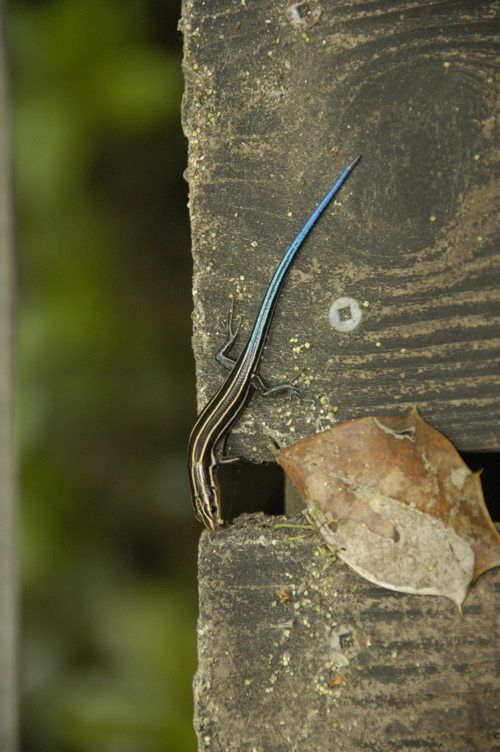 changed my plan for the day. We were going to cover 300 miles today and position ourselves for an early-morning ferry ride to Ocracoke NC on Monday morning. At this writing we are in the clear, between rain bands, but expecting more tonight and tomorrow thanks to a giant low centered over Indiana.
changed my plan for the day. We were going to cover 300 miles today and position ourselves for an early-morning ferry ride to Ocracoke NC on Monday morning. At this writing we are in the clear, between rain bands, but expecting more tonight and tomorrow thanks to a giant low centered over Indiana.
With rain, everything slows down. Disconnecting the utilities in the rain, visiting the dump station in the rain, towing on I-95 in the rain ““ all of these things take more time. We will have to set our goals a little lower, and possibly get up earlier on Monday to make up for it if we have to pause later today.
May 9, 2008 at 11:59 pm · Filed under Places to go, Roadtrips
We passed a warm and humid night, parked in the back of Cracker Barrel, with all three Fantastic Vents running to circulate some air. Thank goodness for those fans. On nights like that, they are the best upgrade we ever installed. We’ve even survived boondocking on 100-degree nights in Death Valley with them.
Our plan shaped up enough for us to know where we were going today. We towed just 118 miles up to Santee, SC, and the Santee State Park on Lake Marion. It’s a large shady park with two campgrounds in mixed deciduous forest, and it would be a fine overnight stop for anyone coming up I-95, but our real goal was to have a place within a reasonable commuting distance of Congaree National Park ““ with 30-amp electrical hookups for the air conditioning.
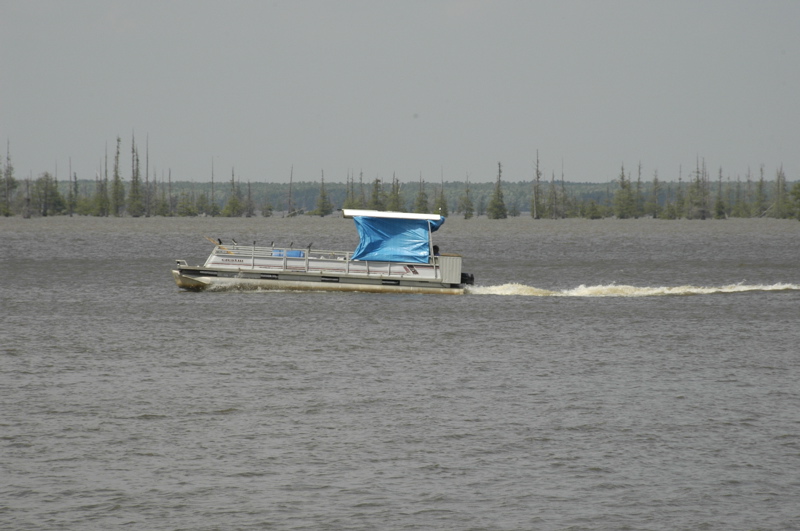 The major theme of Santee State Park seems to be boating on the lake. The lake features a flooded cypress “forest,” which is an unusual feature. Since we didn’t happen to strap a boat to the roof of the Honda, we walked the ¾ mile nature trail instead.
The major theme of Santee State Park seems to be boating on the lake. The lake features a flooded cypress “forest,” which is an unusual feature. Since we didn’t happen to strap a boat to the roof of the Honda, we walked the ¾ mile nature trail instead.
Frankly, there wasn’t a lot of interesting nature revealing itself on the trail, except insects such as spiders, beetles and ticks. Emma discovered a few ticks on her shoes from a short sojourn off the trail into some grass, but fortunately I’d sprayed her legs with bug repellent before the hike and we were able to evict the ticks before they got a nibble of her.
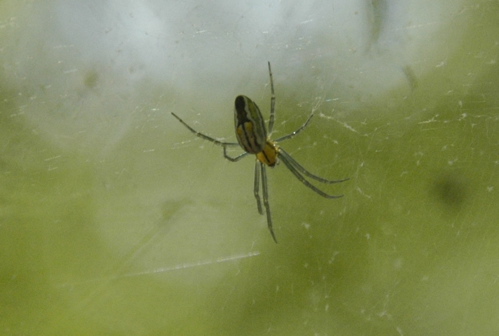 For most of the hike I was elected to walk in front so my face would collect the webs strung across the path, and I eventually amassed quite a collection of them. Finally I started keeping my eyes open for spider webs, and that led to my involvement in trying to photograph spiders in their webs. It’s a worthy photographic challenge, one which will probably keep me occupied for a while just like hummingbirds and bees have occupied me at various times. Right off the bat I can see I don’t have the right lens for the job “¦
For most of the hike I was elected to walk in front so my face would collect the webs strung across the path, and I eventually amassed quite a collection of them. Finally I started keeping my eyes open for spider webs, and that led to my involvement in trying to photograph spiders in their webs. It’s a worthy photographic challenge, one which will probably keep me occupied for a while just like hummingbirds and bees have occupied me at various times. Right off the bat I can see I don’t have the right lens for the job “¦
Even in the shade of the trees, the humidity slowed me down. Just that little walk made me look forward to some air conditioning. We have not yet escaped the southeast humidity, and it’s likely we’ll find more of the same up north in a few weeks. I’m going to have a tough readjustment to northeast summer conditions.
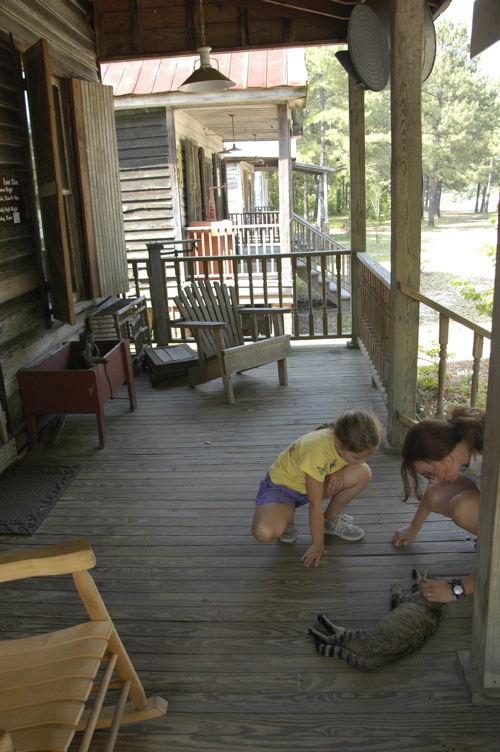 South Carolina can be such a polite place. I haven’t heard Eleanor referred to as “ma’am” more than once or twice a year, but here she has gotten that treatment half a dozen times this evening.
South Carolina can be such a polite place. I haven’t heard Eleanor referred to as “ma’am” more than once or twice a year, but here she has gotten that treatment half a dozen times this evening.
The peak of “sir” and “ma’am” occurred when we stopped at the Lone Star Barbecue & Mercantile for the nightly dinner buffet. This place is built out of four buildings recycled from the former community of Lone Star: O.K. Zeagler’s General Store, the post office, Dantzler’s Social Hall, and Schuler’s General Store. Now connected together along State Park Road, they make a popular restaurant. On Saturday nights the line can go “all the way out to the oak tree,” we were told.
Maybe I was just hungry, but I can recommend the Lone Star for a taste of local food. It’s nothing fancy, just good southern cooking. Between the three of us, we had fried chicken, green beans, “tomato pie,” mashed potatoes, “hash” (a semi-sweet puree of beef, I think) over rice, macaroni & cheese, banana pudding, and Indian pudding with butterscotch topping for dessert. $9.99 for adults and we sure didn’t leave hungry. Being just a couple of miles off I-95, this place is a great lunch or dinner stop for anyone passing by.
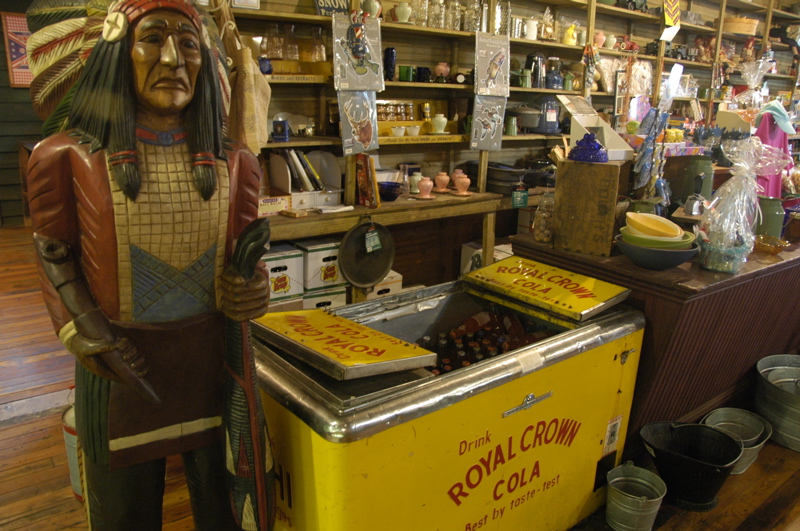
Fuel report: towing at 60 MPH on the flatness of I-95 through Georgia and South Carolina, with the A/C on and only mild crosswinds, the Armada got 11.0 miles per gallon. That’s about the best it has ever done, and fairly good for a gas engine pulling an 8000 lb trailer.
By comparison, towing at 72 MPH in west Texas, in similar conditions, the Armada got between 8.6 and 8.9 MPG. That means going 60 saved us about 20% on our fuel bill. I’m going to work a 60 MPH speed limit into all my long-distance travel plans going forward.
« Previous entries ·
Next entries »
 We have yet seen them, but their signs are everywhere. Hoof prints are in the sand by our campsite, and horse manure is scattered along the narrow campground roads. In backing up the Airstream I was forced to drive right through a nice heap of manure, which is the first time that’s happened in our travels.
We have yet seen them, but their signs are everywhere. Hoof prints are in the sand by our campsite, and horse manure is scattered along the narrow campground roads. In backing up the Airstream I was forced to drive right through a nice heap of manure, which is the first time that’s happened in our travels.

























